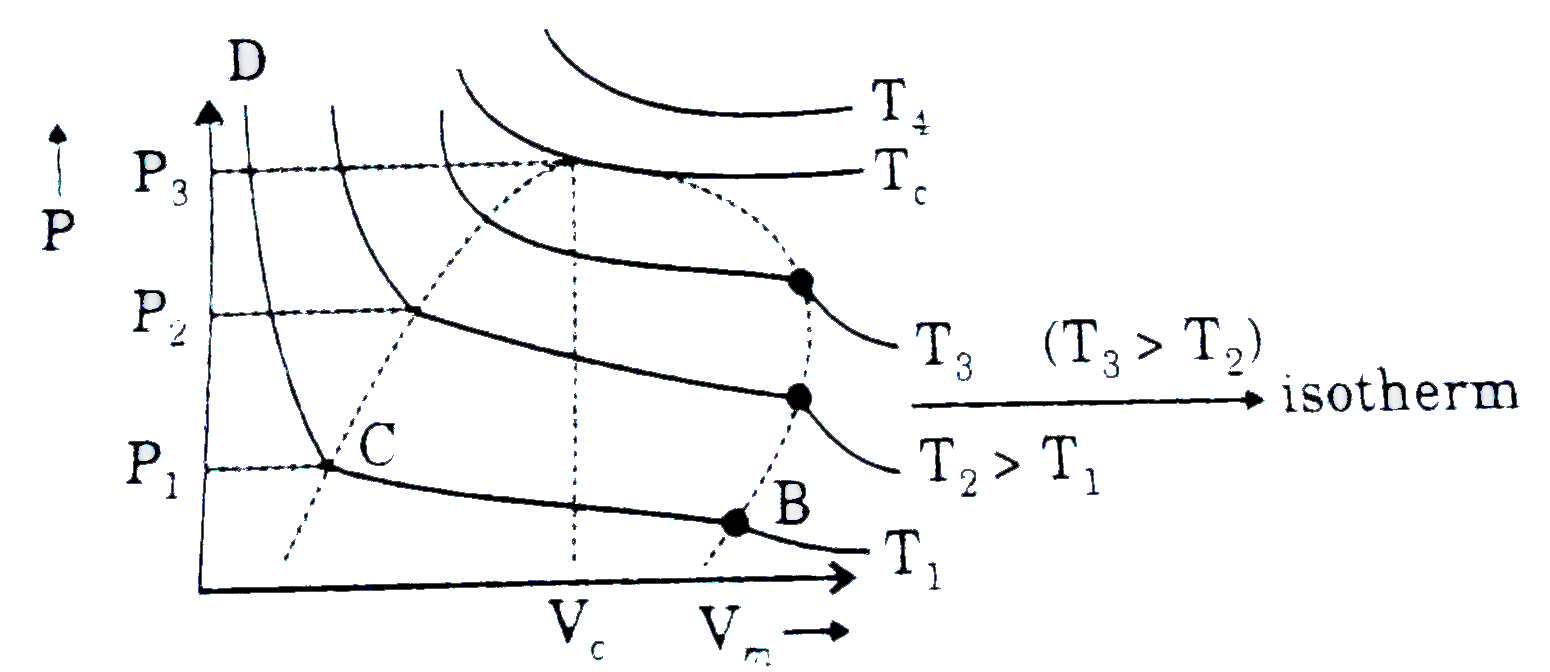When perssure is increase at constant temperature, volume of gas decreases, AB → gases,Bc → vapour + liquid ,CD →liquid critical point .At this all the physical properties of liquid phase as density of liquid = density if vapour.
Te or critical temp : Temperature above which a gas can not be liquified
Ve or critical volume : Volume occupied by one mole of gas at Te abd Pe.

Critical constant Using van der Waals' Equations
(P+aV2m)(Vm−b)=RT
⇒(PV2m+a)(Vm−b)=RTV2m
PV3m+aVm−PbV2m=ab−RTV2m=0
⇒V3m−V2m(b+RTeP)+apVm−abp=0
Since equation is cubic in Vm hence there will be roots of equation at any temperature and pressure.At critical point van der Waals' equation will be
V3m−V2m(b+RTcPc)+apcVm−abpc=0 ....(i)
But at critical point all three roots of the equation should be equal, hence equation should be :
Vm=Vc
(Vm−Vc)3=0
Vm−3V2mVc+3VmV2c−V3c=0....(ii)
Comparing with equation (i)
b+RTcpc=3Vc ...(iii)
apc=3V2e...(iv)
abpc=V3c....(v)
from eqns.(iv) and (v0, Vc=3b
from eq. (iv) pc=a3V2c substituting pc=a3(3b)2=a27b2
from e.q (iii) RTcpc=3Vc−b=9b−b=8b
⇒Tc=8a27Rb
At critical point, the slope of PV curve (slope of isotherm) will be zero at all other point slpoe will be negative zero is the maximum value of slope
(∂P∂Vm)Tc=0...(iv)
∂∂Vm(∂P∂Vm)Tc=0
[Mathematically such points are known as point of inflection (where first two derivatives becomes zero) Using the two TcPc and Vc can be calculated
If the critical constants for a hypothetical van der Waals' gas are Vc=150cm2mol−1,pc=300K Then the approxomate radius of the molecule is :
(TakeR=112Latmmol−1K−1]
(752πNA)1/3
(758πNA)1/3
(3πNA)1/3
(3256πNA)1/3
The correct Answer is:B
Topper's Solved these Questions
- GRAPHICAL INTERPRETATIONBOOK - GRB PUBLICATIONCHAPTER - GRAPHICAL INTERPRETATIONEXERCISE - Comprehension 2
1 Videos
- GRAPHICAL INTERPRETATIONBOOK - GRB PUBLICATIONCHAPTER - GRAPHICAL INTERPRETATIONEXERCISE - Comprehension 3
1 Videos
- GRAPHICAL INTERPRETATIONBOOK - GRB PUBLICATIONCHAPTER - GRAPHICAL INTERPRETATIONEXERCISE - Comprehension 1
1 Videos
- F-BLOCK ELEMENTSBOOK - GRB PUBLICATIONCHAPTER - F-BLOCK ELEMENTSEXERCISE - Subjective type
7 Videos
- HYDROCARBON (ALIPHATIC)BOOK - GRB PUBLICATIONCHAPTER - HYDROCARBON (ALIPHATIC)EXERCISE - Previous years jee questions
28 Videos
Similar Questions
One mole of an ideal gas undergoes a process (10L, 4atm) to (4L, 10 atm ). The process may be represented by straight line in P-V diagram
The correct statement for the process :
View SolutionIn order to perdict variation of Gibbs free energy with progress of reaction at constant temperature and 1 bar pressure, it is important to know realtive stability of the components involved in chemical reaction at standard useful work then the change in Gibbs free energy should be calculated
Which of the following options correctly represects the graph between Gibbs free energy (G0 and state of reaction (SOR) at 1 bar and 300 K for the reaction But -1 ene (A) ⇔ but -2 ene (B)
View SolutionEvery reaction whether started by taking only reactants or by taking only products or any other combination always has a tendency to move towards equilibrium. Hence, equilibrium state can be considered as the one with most stable composition. In case of isomers, based on stability data position of equilibrium can als be decided.
Which of the following options correctly represent ΔG∘f of cis but-2-ene, trans but-2-ene and but-1-ene in kJ/mole?
View SolutionThe first f-block organometallic compound [ThH(OR)(C5Me5)2] was prepared in late 1970s. Find the oxidation state of central metal atom/cation.
View SolutionWhich of the following will decolourise alkaline KMnO4?
View SolutionWhat happens if a liquid is heated to the critical temperature of its vapour?
View SolutionA volume occupied by a saturated vapour is reducd n times at a constant temperature. What fraction η of the final volume is occupied by the liquid if the specific volume of saturated vapour be N times greatr than the specific volume of the corresponding liquid?
View SolutionWhich one of the following is / true :-
(i) At critical temp the surface separating two phases disappears
(ii) below critical temperature a gas is called vapour
(iii) A gas can't be liquified below critical temp.
(iv) Higher the critical temp. difficult to liquify a gas
View SolutionAssertion (A) At critical temperature liquid passes into gaseous state imperceptibly and continuously. Reason (R) The density of liquid and gaseous phase is equal to critical temperature.
View Solution(A) Meniscus of a liquid disappears at the critical temperature. (R) Density of liquid and its gaseous phase become equal at the critical temperature.
View SolutionThe essential conditions for liquefaction of gases were discovered by Andrews in 1869 as a result of his study of pressure-volume-temperature relationship for CO_(2) . If was found that above a certain temperature, it was impossible to liquefy a gas whatever the pressure was applied. The temperature below which the gas can be liquefied by the application of pressure alone is called critical temperature (T_(c)) . The pressure required to liquefy a gas at this temperature is called the critical pressure (P_(c)) . The volume occupied by one mole of the substance at the critical temperature and pressure is called critcal volume. Critical constants are related with van der Waals' constant as follows: V_(c) = 3b, P_(c) = (a)/(27b^(2)), T_(c) = (8a)/(27 Rb) At critical point, the meniscus between liquid and vapour disappears due to:
View SolutionAssertion (A) At critical temperature liquid passes into gaseous state imperceptibly and continuously.
Reason (R) The density of liquid and gaseous phase is equal to critical temperature.
View SolutionAssertion. At the critical temperature, the densities of the gaseous and liquid phase become equal. Reason. At the critical point, surface of separation between the liquid phase and the gaseous phase disappears.
View SolutionAssertion. Menscus of a liquid disappears at critical temperature. Reason. Density of a liquid and its gaseous phase become equal at the critical temperature.
View SolutionA sample of gas has a volume of V1 litre at temperature t1.∘C. When the temperature of the gas is changed to t2.∘C at constant pressure, then the volume of the gas was found to increase by 10%. The percentage increase in temperature is
View SolutionWhat happens when a liquid a heated to the critical temperature of its vapour?
View Solution
